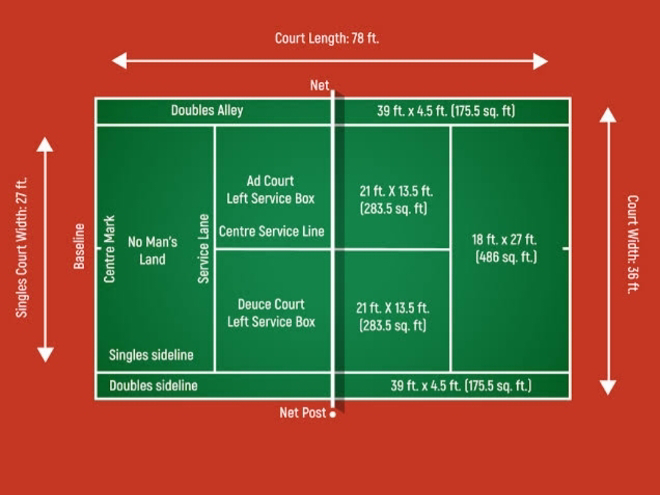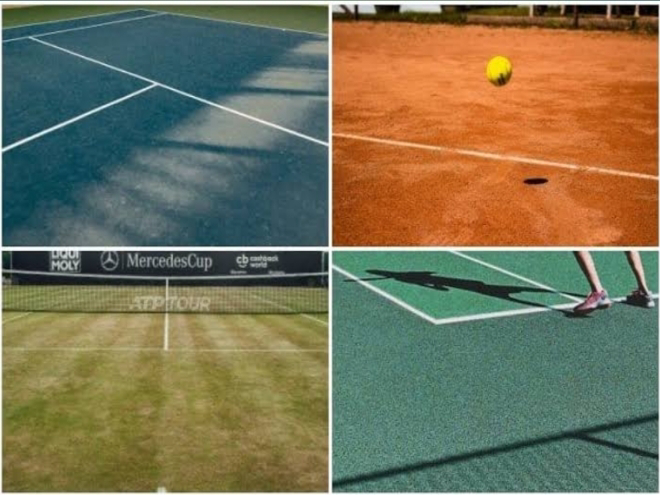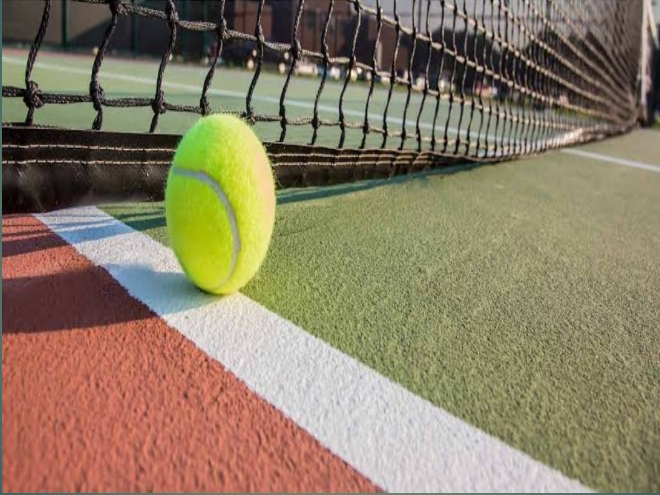Tennis, often referred to as the "sport of a lifetime," captivates enthusiasts and athletes worldwide with its blend of athleticism, strategy, and precision. Central to the essence of tennis is the playing surface itself – the tennis court. To appreciate the intricacies of this dynamic sport, one must first grasp the standardized dimensions that define the court. In this comprehensive guide, we explore the dimensions of a tennis court, shedding light on the lengths, widths, and key components that shape the battleground for intense rallies and skillful serves. Whether you're a novice eager to understand the basics or a seasoned player seeking a deeper insight, join us on a journey to unravel the dimensions that form the foundation of every exhilarating tennis match.
The Standard Tennis Court Dimensions:
 |
| Source image - Perfect Tennis |
At the heart of every competitive tennis match lies a meticulously designed playing surface adhering to strict standards set by the International Tennis Federation (ITF). These dimensions, carefully crafted to ensure fairness and consistency, define the stage upon which athletes showcase their skills. Let's delve into the specific measurements that characterize a standard tennis court:
(1) Court Length (78 feet/23.77 meters):
The length of a tennis court is a critical parameter, measuring precisely 78 feet (23.77 meters) from baseline to baseline. This vast expanse provides ample room for players to engage in lengthy baseline rallies and execute strategic plays.
(2) Court Width (27 feet/8.23 meters for Singles, 36 feet/10.97 meters for Doubles):
The width of the court varies depending on whether it hosts a singles or doubles match. For singles, the court spans 27 feet (8.23 meters), while doubles matches extend the width to 36 feet (10.97 meters). This adjustment accommodates the dynamic nature of doubles play, where quick exchanges and coordinated teamwork are paramount.
(3) Net Height (3 feet/0.914 meters at Center, 3.5 feet/1.07 meters at Posts):
Suspended at the center of the court, the net is set at a height of 3 feet (0.914 meters). However, at the net posts, it is slightly elevated to 3.5 feet (1.07 meters). This subtle incline ensures a level playing field and influences the trajectory of shots during play.
(4) Baseline:
The baseline serves as the rear boundary of the court. Players serve from behind this line, and its position is integral to scoring and determining the legality of serves. The baseline is a constant reference point for players as they navigate the court.
(5) Service Boxes (21 feet/6.4 meters length, 13.5 feet/4.11 meters width):
Positioned on either side of the net, the service boxes are rectangular areas where players execute their serves. Each service box is 21 feet (6.4 meters) in length and 13.5 feet (4.11 meters) in width, providing a designated space for serving and receiving.
(6) Center Service Line:
Running perpendicular to the net, the center service line divides the court into two equal halves. It plays a crucial role in determining the legality of serves and helps players maintain accurate positioning during the game.
(7) Singles Sidelines:
In singles matches, the singles sidelines run parallel to the doubles sidelines, defining the lateral boundaries of the court. Shots landing outside these lines are considered out of play.
(8) Doubles Alleys (4.5 feet/1.37 meters wide):
Exclusively used in doubles matches, the doubles alleys flank the singles court on either side, adding an extra 4.5 feet (1.37 meters) to the width. These alleys expand the playing area for doubles players, introducing additional strategic elements to their game.
Understanding these standardized tennis court dimensions is not only essential for players but also contributes to the enjoyment and fairness of the game. As athletes step onto the court, they engage in a dance of precision within these meticulously measured confines, showcasing the true beauty and athleticism that define the sport of tennis.
More News:
What are the dimensions of a football ground?
Surface Variations:
 |
| Source image - My Tennis HQ |
While the standardized dimensions provide a consistent framework for tennis courts worldwide, the playing surface itself can vary significantly. The type of surface impacts the speed of the game, ball bounce, and overall playing experience. Tennis enthusiasts and professionals encounter three primary surface variations, each with its distinct characteristics:
(1) Clay Tennis Courts:
Composition:
Composed of crushed stone, brick, or shale, clay courts offer a unique playing surface that is softer compared to other types.
Speed and Bounce:
Clay courts are known for slowing down the pace of the game. The ball tends to bounce higher and slower, allowing players more time to react and making it conducive to baseline rallies.
Maintenance:
Regular maintenance, including rolling and watering, is essential to keep the clay in optimal playing condition.
Prominent Tournament:
The French Open, hosted at Roland Garros in Paris, is the most prestigious Grand Slam tournament played on clay courts.
(2) Grass Tennis Courts:
Composition:
Grass courts are traditionally made of natural grass, though some modern variations use synthetic grass.
Speed and Bounce:
Grass courts provide a fast and low-bounce surface. The ball skids through the grass, making it challenging for opponents to predict and respond quickly.
Maintenance:
Grass courts demand meticulous maintenance, including regular mowing and irrigation, to ensure a smooth and even surface.
Prominent Tournament:
Wimbledon, the oldest tennis tournament in the world, is renowned for its lush grass courts and is considered the epitome of grass court tennis.
(3) Hard Tennis Courts:
Composition:
Hard courts are constructed using asphalt or concrete as a base, covered with a layer of acrylic material.
Speed and Bounce:
Hard courts offer a medium-paced playing surface, striking a balance between the speed of grass and the slower pace of clay. The ball's bounce is relatively predictable and consistent.
Maintenance:
Hard courts generally require less maintenance than clay or grass courts. This courts are resilient and can withstand a range of weather conditions.
Prominent Tournaments:
The US Open, the Australian Open, and many other major tournaments are played on hard courts, making them one of the most widely used surfaces in professional tennis.
Players often develop specific strengths and playing styles suited to particular surfaces, and the annual Grand Slam tournaments, each played on a different surface, showcase the versatility of the top-ranked players. As competitors transition from clay to grass to hard courts throughout the season, they adapt their game to the unique challenges posed by each surface. The diversity of tennis surfaces adds a fascinating dimension to the sport, offering players and fans a varied and exciting spectacle.
(4) Carpet Tennis Courts:
Carpet tennis courts, known for their unique playing surface, provide an intriguing blend of speed and consistency. Composed of synthetic materials resembling carpeting, these courts offer a smooth and fast-paced playing experience. The carpet surface, often made of acrylic materials, ensures a uniform bounce and adds an element of predictability to the game. Renowned for their indoor installations, carpet tennis courts have become a staple in professional tournaments, providing players with a controlled environment and reducing the impact of external factors like weather. The surface is appreciated for its resilience and low-maintenance nature, making it a favorable choice for facilities aiming to offer year-round play. Step onto a carpet tennis court, and you'll find yourself navigating a surface that combines speed, precision, and a touch of luxury, providing an extraordinary tennis experience for players and spectators alike.
More News:
A Glorious Journey: Unraveling the Tapestry of NBA Champions
Conclusion:
In the dynamic world of tennis, the dimensions and surfaces of the court form the canvas upon which athletes paint their masterpieces. The standardization of tennis court dimensions by the International Tennis Federation ensures a level playing field for competitors across the globe, fostering fair and exciting matches. From the precision of the baseline to the strategic placement of service boxes, each element contributes to the sport's rich tapestry.
As players step onto the court, they navigate the standardized dimensions with finesse, executing powerful serves, engaging in lightning-fast rallies, and showcasing the athleticism that defines tennis. The meticulous design of the tennis court provides the framework for the sport's intensity and drama, inviting players to conquer the challenges presented by the length, width, and net height.
Surface variations further elevate the complexity of the game, offering distinct challenges that test the adaptability and versatility of players. Whether sliding on clay, gliding across grass, or maneuvering on the resilient hard courts, athletes demonstrate their ability to excel on diverse terrains.
In conclusion, tennis court dimensions are not just measurements on paper; they are the boundaries within which the magic of tennis unfolds. As players and fans alike witness the ebb and flow of matches, they witness the interplay of strategy, skill, and athleticism within the standardized dimensions. The variety of surfaces adds an extra layer of intrigue, ensuring that no two tournaments are alike.
Tennis, with its rich history and global appeal, continues to evolve within the confines of these dimensions, captivating audiences and inspiring a new generation of players. The court, with its precise measurements and diverse surfaces, remains the stage for breathtaking moments, epic rivalries, and the celebration of the enduring spirit of the sport – a timeless testament to the magic that happens within the lines of a tennis court.
More News:


No comments:
Post a Comment